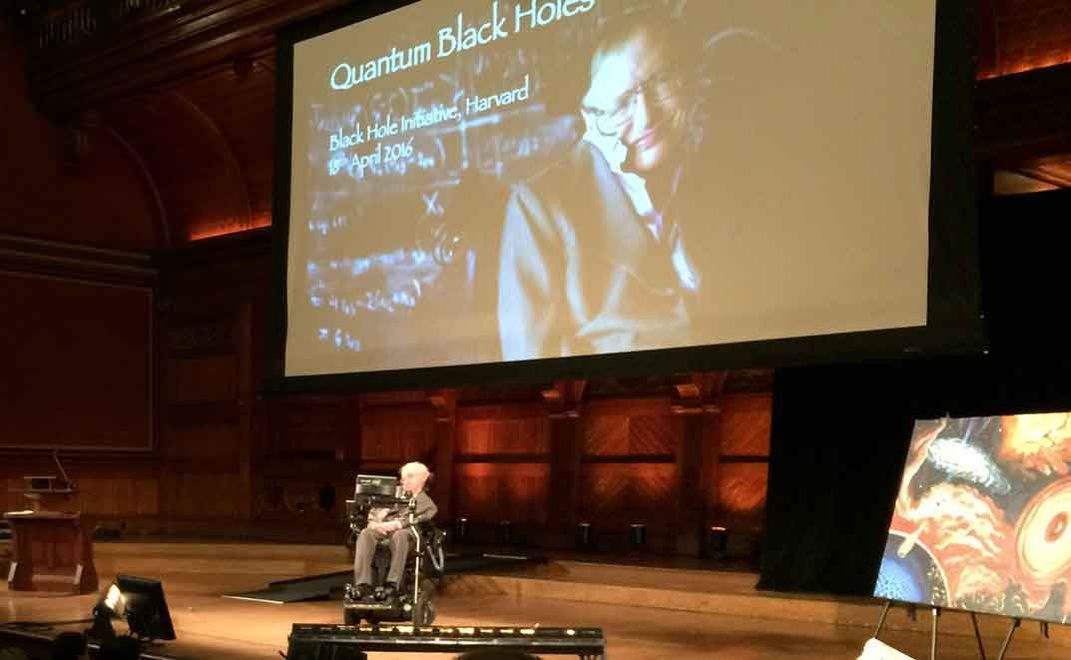Stephen Hawking on Why Black Holes Are Worthy of Your Consideration
A new Harvard-Smithsonian initiative will delve into the places in the universe where spacetime sags around massive objects
/https://tf-cmsv2-smithsonianmag-media.s3.amazonaws.com/filer/b5/63/b56330e2-a779-4da6-a593-ae7b7510f1d5/cygx1illweb.jpg)
As research subjects, black holes have never been more luminous.
But in the 1970s, the renowned physicist Stephen Hawking said that he found them vexing. Although he accepted the common wisdom that black holes were completely black, his equations showed that they emitted particles, giving off a faint glow we now call Hawking radiation. “I therefore put quite a lot of effort into trying to get rid of this embarrassing effect,” he said. “But the more I thought about it, the more it refused to go away.”
On April 18, in Harvard University’s Sanders Theatre, Hawking gave a lecture to inaugurate a new Black Hole Research Initiative to be headquartered at the university in partnership with the Harvard-Smithsonian Center for Astrophysics.
This effort is aimed at probing how these entities behave—and the mind-bending mystery of what happens when you venture inside them.
The new initiative, directed by Harvard astrophysicist Avi Loeb, puts an exclamation point on what has already been a pretty good century for black holes. A fresh highlight came this past February, when the Laser Interferometer Gravitational-Wave Observatory (LIGO) reported the first detection of gravitational waves, confirming a key prediction of Albert Einstein’s theory of general relativity. These ripples in spacetime were set off by the distant collision of two black holes, each a few dozen times heavier than the Sun.
That signal offered perhaps the most tangible evidence yet that such bizarre objects really exist. Better still, it showed that they move the way scientists have calculated they should. “LIGO has opened a new window in our universe,” Hawking said at Harvard. “With more detections expected, I am excited by the possibility of new discoveries.”

But as much as black holes draw the spotlight, with their strange properties now accepted facts, Hawking’s own story reflects the winding path these objects took to get there.
Multiple speakers recalled how in 1915, Einstein first presented his theory of general relativity, an account of reality in which spacetime sags around massive objects. Less than a month after Einstein’s final lecture to the Berlin Academy, astronomer Karl Schwarzschild came up with the first complete solution to Einstein’s equations.
This triumph came with a troubling footnote: The solution implied a small sphere of space could exist from which nothing, not even light, could escape. Einstein, impressed by Schwarzchild’s mathematical ingenuity, nonetheless was doubtful that such a thing could be anything more than a thought experiment. Schwarzchild assumed so, too. It was “clearly not physically meaningful,” he wrote in a journal article.
Today, we recognize that these so-called “magic spheres” can and do exist. We know, for example, that every self-respecting galaxy has one at its core. But the same pattern shows up again and again in the black hole story, a saga also recounted by science writer Marcia Bartusiak in her 2015 book Black Hole. When physicists venture near this topic, they tend to get sucked into thorny, unexpected problems that defy easy explanation.
Like black holes themselves, Hawking’s radiation is now accepted. But even today, his chief insight, expressed in an equation that relates a black hole’s surface to the information trapped inside, is still stirring up trouble. “Black holes obey a very elegant and simple equation,” said Andrew Strominger, a physicist who collaborates with Hawking and will join the new initiative. “We have no idea what it means. We are as deeply confused by this equation as Einstein was in the 1930s about Schwarzschild’s solution.”
Solving this riddle to explain how black holes record details about the matter they swallow is a major goal of the Harvard-Smithsonian initiative. Other open questions include the origin of massive black holes seen in the distant universe as bright quasars, and the ways in which giant black holes shape the galaxies that orbit them.
Loeb, the program’s founding director, thinks he has assembled a team with a good chance of finding answers—and he’s not above acting as hype man. If the United Nations asked him to come up with a list of black hole experts for an interstellar science competition, he mused, whom would he pick?
“Frankly, the top people on my list are in the team,” he said, to laughter. “I think with this team we can beat anyone in the Milky Way, that’s for sure. I don’t know about the universe at large.”
After a century in which black holes went from theoretical nuisances to undisputed facts, his tongue-in-cheek positivity may reflect a change in attitudes. Whereas the contradictions and confusions of black holes at first “embarrassed” researchers like Hawking, the same knotty problems are now major draws for research teams like LIGO and Loeb’s initiative.
Hawking’s own speech ended with a similar note of optimism. “The message of this lecture is that black holes ain't as black as they are painted,” he said. “If you feel you are in a black hole, don’t give up. There is a way out.”
/https://tf-cmsv2-smithsonianmag-media.s3.amazonaws.com/accounts/headshot/SOKOL11.jpg)
/https://tf-cmsv2-smithsonianmag-media.s3.amazonaws.com/accounts/headshot/SOKOL11.jpg)